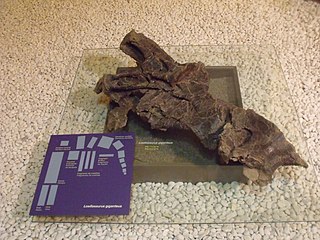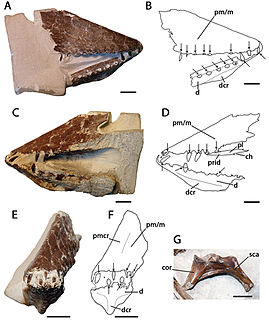
The eastern grey kangaroo is a marsupial found in the eastern third of Australia, with a population of several million. It is also known as the great grey kangaroo and the forester kangaroo. Although a big eastern grey male typically weighs around 66 kg (146 lb) and stands almost 2 m tall, the scientific name, Macropus giganteus, is misleading: the red kangaroo of the semi-arid inland is larger, weighing up to 90 kg (200 lb).

Miscanthus, or silvergrass, is a genus of African, Eurasian, and Pacific Island plants in the grass family.

Losillasaurus is a genus of sauropod dinosaur from the Late Jurassic and possibly Early Cretaceous (Kimmeridgian-?Berriasian) in the southeast of Spain. The type species of the turiasaurian Losillasaurus giganteus was discovered in the Villar del Arzobispo Formation in Valencia and formally described by Casanovas, Santafé and Sanz in 2001. The holotype material is from a subadult and includes part of a skull; complete cervical, dorsal, sacral, and caudal vertebrae as well as several fragments; skeletal elements from the limbs including a humerus, ulna, radius, and metacarpal; sternal plates; and from the pelvis: the ilium, ischium, and pubis. The genus is characterized by the dimension and shape of the neural spine of the proximal caudal vertebrae. The humerus is 143 centimetres (56 in) long, which despite being from a subadult specimen is within 20% of the size of Paralititan. The size estimation proposed by Francisco Gascó in his master thesis is 15–18 m (49–59 ft) and 12-15 tons.

Mastodonsaurus is an extinct genus of temnospondyl amphibian from the Middle Triassic. It belongs to a Triassic group of temnospondyls called Capitosauria, characterized by their large body size and presumably aquatic lifestyles.

Spirobranchus giganteus, commonly known as the Christmas tree worm, is a tube-building polychaete worm belonging to the family Serpulidae.

Indopithecus giganteus is an extinct species of large ape that lived in the late Miocene of the Siwalik Hills in northern India. Although frequently assigned to the more well-known genus Gigantopithecus, recent authors consider it to be a distinct genus in its own right.

The Indian flying fox, also known as the greater Indian fruit bat, is a species of flying fox found in the Indian subcontinent. It is one of the largest bats in the world. It is of interest as a disease vector, as it is capable of transmitting several viruses to humans. It is nocturnal and feeds mainly on ripe fruits, such as mangoes and bananas, and nectar. This species is often regarded as vermin due to its destructive tendencies towards fruit farms, but the benefits of its pollination and seed propagation often outweigh the impacts of its fruit consumption.

Chorus giganteus is a species of sea snail in the family Muricidae. It is endemic to the coast of Chile, where it occurs from Antofagasta (23° S) to the south of the country at depths of 8–30 metres (26–98 ft). It is a benthic predator that lives on rocks in temperate waters. It has been overexploited by local fishermen in much of its range.

A giant isopod is any of the almost 20 species of large isopods in the genus Bathynomus. They are abundant in the cold, deep waters of the Atlantic, Pacific, and Indian Oceans. Bathynomus giganteus, the species upon which the generitype is based, is often considered the largest isopod in the world, though other comparably poorly known species of Bathynomus may reach a similar size. The giant isopods are noted for their resemblance to the much smaller common woodlouse, to which they are related.

The Rookery Islands are a group of rocks and small islands in western Holme Bay, north of the David and Masson Ranges, on the Mawson Coast of Mac.Robertson Land in East Antarctica. The largest in the group are Giganteus Island in the north-west, 600 m long by 400 m wide, and Rookery Island in the south, 1 km long and 250 m wide. The islands are rocky and of low relief, rising to heights of 60 m on Rookery Island, 25 m on Giganteus Island, and ranging from 10 – 30 m on the smaller islands. The nearest permanent research station is Australia's Mawson, some 15 km to the east in Holme Bay.

Lonchodraco is a genus of lonchodraconid pterodactyloid pterosaur from the Late Cretaceous of southern England. The genus includes species that were previously assigned to other genera.
Gyaritini is a tribe of longhorn beetles of the subfamily Lamiinae. It was described by Breuning in 1956.
Gyaritus is a genus of longhorn beetles of the subfamily Lamiinae, containing the following species:
Gyaritus affinis is a species of beetle in the family Cerambycidae. It was described by Stephan von Breuning in 1938.
Gyaritus gahani is a species of beetle in the family Cerambycidae. It was described by Stephan von Breuning in 1938.
Gyaritus bangueyensis is a species of beetle in the family Cerambycidae. It was described by Stephan von Breuning in 1958. It is known from Banguey Island.
Gyaritus spinosus is a species of beetle in the family Cerambycidae. It was described by Stephan von Breuning in 1939. It is known from Borneo.
Gyaritus fulvopictus is a species of beetle in the family Cerambycidae. It was described by Francis Polkinghorne Pascoe in 1864. It is known from Borneo.
Gyaritus fuscosignatus is a species of beetle in the family Cerambycidae. It was described by Stephan von Breuning and de Jong in 1941.
Gyaritus lungtauensis is a species of beetle in the family Cerambycidae. It was described by Gressitt in 1951. It is known from China.










